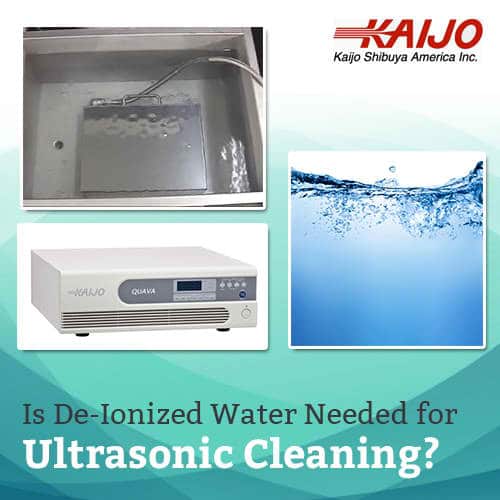Is De-Ionized Water Needed for Ultrasonic Cleaning?
January 7, 2020
 The use of de-ionized water can improve the cleaning performance of many applications using ultrasonic cleaning systems and for rinsing cleaned components. For lightly contaminated parts or for parts that can withstand the robust cleaning of low ultrasonic frequencies, cleaning with ordinary water is often enough. For parts that are more heavily contaminated or for fragile parts, cleaning with a mild detergent can be effective. On parts that can’t withstand the use of detergents and for delicate parts, the use of de-ionized water is the best way of speeding up the cleaning process and ensuring even and complete cleaning.
The use of de-ionized water can improve the cleaning performance of many applications using ultrasonic cleaning systems and for rinsing cleaned components. For lightly contaminated parts or for parts that can withstand the robust cleaning of low ultrasonic frequencies, cleaning with ordinary water is often enough. For parts that are more heavily contaminated or for fragile parts, cleaning with a mild detergent can be effective. On parts that can’t withstand the use of detergents and for delicate parts, the use of de-ionized water is the best way of speeding up the cleaning process and ensuring even and complete cleaning.
How De-Ionized Water Helps Ultrasonic Cleaning Performance
Ordinary water contains traces of many kinds of impurities. De-ionized water is first filtered to remove organic matter and then passed through an ion exchange bed. Normal filtration can’t remove dissolved substances such as salts because they form ions in the water and the ions are too small to filter out. The ion exchange resins attract and remove the dissolved ions and the resulting water is very pure.
De-ionized water helps the ultrasonic cleaning process in several ways. Because it doesn’t contain impurities, ultrasonic cleaning applications using de-ionized water and detergents are more effective because the detergents don’t lose any cleaning power by combining with the impurities in the water. For cleaning applications that can’t use detergents, the use of pure de-ionized water absorbs ionized compounds rapidly, promoting quick cleaning. Finally, when detergents are used, the cleaning solution has to be rinsed off after cleaning is complete. If rinsing is carried out with de-ionized water, it doesn’t leave any residue when dry. Rinsing with ordinary water can leave traces of salts or organic films on cleaned parts while de-ionized water evaporates without leaving impurities behind.
Cleaning Applications that Benefit from Using De-Ionized Water
Basic ultrasonic cleaning using ordinary water removes surface contamination from all kinds of parts but cleaning performance can be improved for specific applications. In addition to using de-ionized water, heating the cleaning solution and adding specific solvents or detergents targeted at a contaminant can improve cleaning. Depending on the parts to be cleaned and the nature of the contamination, cleaning with de-ionized water and a mild detergent and/or heating the cleaning solution can result in better cleaning.
Parts such as machined components or metal parts can have metallic dust on the surfaces. The microscopic cavitation bubbles produced by the ultrasonic cleaning systems can dislodge such dust particles and de-ionized water quickly absorbs any of the metallic ions that dissolve in the cleaning solution. This kind of cleaning application benefits from the use of de-ionized water but detergents and heating are not needed.
Engine parts are often coated with oil and heavy grease. For such cleaning applications heating the cleaning solution softens the deposits and adding a mild detergent helps dissolve the oil and grease. Using de-ionized water increases the effectiveness of the detergent.
Plastic parts and semiconductor components may be contaminated with organic residue. Adding a detergent can help remove it but some parts such as printed circuit boards or medical components may be sensitive to detergents. In such cases solvents either can’t be used or their use is limited to specialized detergents that dissolve the organic matter but don’t harm the underlying material. In both cases using de-ionized water doesn’t directly help remove the organic material but does improve the performance of the detergents.
To help customers determine which applications can benefit from the use of de-ionized water, Kaijo offers free consultation to ensure that its ultrasonic cleaning systems satisfy cleaning requirements. The company can help select ultrasonic cleaning components or provide complete turnkey systems. In either case, Kaijo offers in house expertise to help customers achieve their cleaning requirements.





